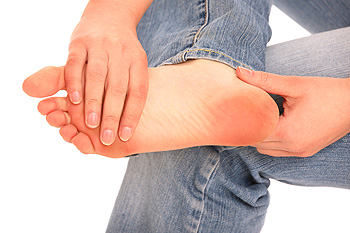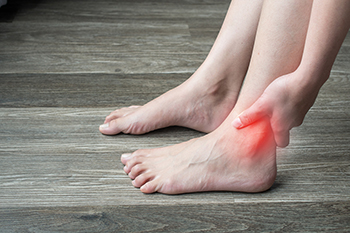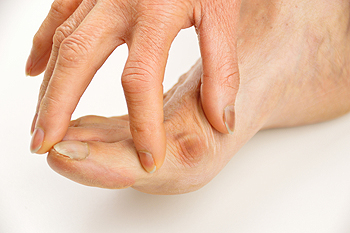Items filtered by date: April 2022
Foot Pain Can Come From Sporting Activities

Young athletes may be prone to developing foot pain for various reasons. It may develop as a result of engaging in specific types of sporting activities that involve running and jumping. Foot injuries that happen gradually can include stress fractures and tendonitis and can produce a considerable amount of pain. Acute injuries can consist of a fracture, sprain, or bruise, and can cause severe pain and discomfort. Many people who endure this type of injury often need to have an X-ray taken, which can provide a proper diagnosis. There are methods that can be implemented which may help to prevent foot pain. These can include wearing shoes that fit correctly and replacing them approximately every three to four hundred miles. If your child has foot pain and is active in sports, please confer with a podiatrist who can recommend the correct treatment techniques.
Foot Pain
Foot pain can be extremely painful and debilitating. If you have a foot pain, consult with Dr. John P. Beaupied from Palos Podiatry. Our doctor will assess your condition and provide you with quality foot and ankle treatment.
Causes
Foot pain is a very broad condition that could be caused by one or more ailments. The most common include:
- Bunions
- Hammertoes
- Plantar Fasciitis
- Bone Spurs
- Corns
- Tarsal Tunnel Syndrome
- Ingrown Toenails
- Arthritis (such as Gout, Rheumatoid, and Osteoarthritis)
- Flat Feet
- Injury (from stress fractures, broken toe, foot, ankle, Achilles tendon ruptures, and sprains)
- And more
Diagnosis
To figure out the cause of foot pain, podiatrists utilize several different methods. This can range from simple visual inspections and sensation tests to X-rays and MRI scans. Prior medical history, family medical history, and any recent physical traumatic events will all be taken into consideration for a proper diagnosis.
Treatment
Treatment depends upon the cause of the foot pain. Whether it is resting, staying off the foot, or having surgery; podiatrists have a number of treatment options available for foot pain.
If you have any questions, please feel free to contact our office located in Palos Heights, IL . We offer the newest diagnostic and treatment technologies for all your foot care needs.
Possible Causes of Blisters
 Blisters on the feet can be uncomfortable, painful, and if infected, can become a serious health issue. Blisters are a small pocket of fluid that develops over a damaged portion of skin. This is the body’s natural defense in protecting the area as new skin forms. Blisters can develop from wearing shoes that do not fit correctly, and this can cause the foot to rub against the shoe. Many patients find it helpful to keep their feet as dry as possible, and this can aid in preventing blisters. Additionally, blisters can develop from a severe sun or chemical burn, frostbite, or possibly from an allergic reaction. If you have developed blisters on your feet, it is suggested that you speak to a podiatrist who can guide you toward proper treatment and healing techniques.
Blisters on the feet can be uncomfortable, painful, and if infected, can become a serious health issue. Blisters are a small pocket of fluid that develops over a damaged portion of skin. This is the body’s natural defense in protecting the area as new skin forms. Blisters can develop from wearing shoes that do not fit correctly, and this can cause the foot to rub against the shoe. Many patients find it helpful to keep their feet as dry as possible, and this can aid in preventing blisters. Additionally, blisters can develop from a severe sun or chemical burn, frostbite, or possibly from an allergic reaction. If you have developed blisters on your feet, it is suggested that you speak to a podiatrist who can guide you toward proper treatment and healing techniques.
Blisters may appear as a single bubble or in a cluster. They can cause a lot of pain and may be filled with pus, blood, or watery serum. If your feet are hurting, contact Dr. John P. Beaupied of Palos Podiatry. Our doctor can provide the care you need to keep you pain-free and on your feet.
Foot Blisters
Foot blisters are often the result of friction. This happens due to the constant rubbing from shoes, which can lead to pain.
What Are Foot Blisters?
A foot blister is a small fluid-filled pocket that forms on the upper-most layer of the skin. Blisters are filled with clear fluid and can lead to blood drainage or pus if the area becomes infected.
Symptoms
(Blister symptoms may vary depending on what is causing them)
- Bubble of skin filled with fluid
- Redness
- Moderate to severe pain
- Itching
Prevention & Treatment
In order to prevent blisters, you should be sure to wear comfortable shoes with socks that cushion your feet and absorb sweat. Breaking a blister open may increase your chances of developing an infection. However, if your blister breaks, you should wash the area with soap and water immediately and then apply a bandage to the affected area. If your blisters cause severe pain it is important that you call your podiatrist right away.
If you have any questions, please feel free to contact our office located in Palos Heights, IL . We offer the newest diagnostic and treatment technologies for all your foot care needs.
The Difference Between a Fractured, Broken, and a Sprained Ankle
 There is no difference between a fractured or broken ankle but many people, even sports coaches, do not know this. A break or a fracture constitutes the loss of bone integrity, and this is true whether there is a hairline crack or the shattering of an ankle bone. To distinguish between a fractured/broken or sprained ankle, an X-ray is needed. Fractures and breaks indicate problems with bones while sprains refer to injuries to ligaments – bands of cartilage that attach bones. You can break a bone and stretch or tear a ligament. Broken/fractured and sprained ankles hurt. If you have injured your ankle, consult with a qualified podiatrist for proper diagnosis and treatment.
There is no difference between a fractured or broken ankle but many people, even sports coaches, do not know this. A break or a fracture constitutes the loss of bone integrity, and this is true whether there is a hairline crack or the shattering of an ankle bone. To distinguish between a fractured/broken or sprained ankle, an X-ray is needed. Fractures and breaks indicate problems with bones while sprains refer to injuries to ligaments – bands of cartilage that attach bones. You can break a bone and stretch or tear a ligament. Broken/fractured and sprained ankles hurt. If you have injured your ankle, consult with a qualified podiatrist for proper diagnosis and treatment.
Ankle pain can have many different causes and the pain may potentially be serious. If you have ankle pain, consult with Dr. John P. Beaupied from Palos Podiatry. Our doctor will assess your condition and provide you with quality foot and ankle treatment.
Ankle pain is any condition that causes pain in the ankle. Due to the fact that the ankle consists of tendons, muscles, bones, and ligaments, ankle pain can come from a number of different conditions.
Causes
The most common causes of ankle pain include:
- Types of arthritis (rheumatoid, osteoarthritis, and gout)
- Ankle sprains
- Broken ankles
- Achilles tendinitis
- Achilles tendon rupture
- Stress fractures
- Tarsal tunnel syndrome
- Plantar fasciitis
Symptoms
Symptoms of ankle injury vary based upon the condition. Pain may include general pain and discomfort, swelling, aching, redness, bruising, burning or stabbing sensations, and/or loss of sensation.
Diagnosis
Due to the wide variety of potential causes of ankle pain, podiatrists will utilize a number of different methods to properly diagnose ankle pain. This can include asking for personal and family medical histories and of any recent injuries. Further diagnosis may include sensation tests, a physical examination, and potentially x-rays or other imaging tests.
Treatment
Just as the range of causes varies widely, so do treatments. Some more common treatments are rest, ice packs, keeping pressure off the foot, orthotics and braces, medication for inflammation and pain, and surgery.
If you have any questions, please feel free to contact our office located in Palos Heights, IL . We offer the newest diagnostic and treatment technologies for all your foot care needs.
Are Bunions Affecting Your Everyday Life?
Permanent Removal May Be Necessary for Bunions
 A bunion is defined as a bony lump on the side of the big toe. It can come from genetic factors, wearing shoes that do not fit correctly, or possibly from enduring a toe injury. As the bunion grows, it can push the big toe closer to the second toe, and larger footwear often needs to be worn. Some patients experience pain and discomfort, and the bunion and surrounding areas can become tender, red, and inflamed. It can be difficult to complete daily activities, and it may impact the ability to exercise. It can help to maintain the correct weight to keep unnecessary pressure off of the foot. If the bunion is severe, surgery may be necessary for permanent removal, and this is referred to as a bunionectomy. If you think you may have a bunion, it is strongly suggested that you visit a podiatrist who can help you to find relief.
A bunion is defined as a bony lump on the side of the big toe. It can come from genetic factors, wearing shoes that do not fit correctly, or possibly from enduring a toe injury. As the bunion grows, it can push the big toe closer to the second toe, and larger footwear often needs to be worn. Some patients experience pain and discomfort, and the bunion and surrounding areas can become tender, red, and inflamed. It can be difficult to complete daily activities, and it may impact the ability to exercise. It can help to maintain the correct weight to keep unnecessary pressure off of the foot. If the bunion is severe, surgery may be necessary for permanent removal, and this is referred to as a bunionectomy. If you think you may have a bunion, it is strongly suggested that you visit a podiatrist who can help you to find relief.
If you are suffering from bunions, contact Dr. John P. Beaupied of Palos Podiatry. Our doctor can provide the care you need to keep you pain-free and on your feet.
What Is a Bunion?
A bunion is formed of swollen tissue or an enlargement of boney growth, usually located at the base joint of the toe that connects to the foot. The swelling occurs due to the bones in the big toe shifting inward, which impacts the other toes of the foot. This causes the area around the base of the big toe to become inflamed and painful.
Why Do Bunions Form?
Genetics – Susceptibility to bunions are often hereditary
Stress on the feet – Poorly fitted and uncomfortable footwear that places stress on feet, such as heels, can worsen existing bunions
How Are Bunions Diagnosed?
Doctors often perform two tests – blood tests and x-rays – when trying to diagnose bunions, especially in the early stages of development. Blood tests help determine if the foot pain is being caused by something else, such as arthritis, while x-rays provide a clear picture of your bone structure to your doctor.
How Are Bunions Treated?
- Refrain from wearing heels or similar shoes that cause discomfort
- Select wider shoes that can provide more comfort and reduce pain
- Anti-inflammatory and pain management drugs
- Orthotics or foot inserts
- Surgery
If you have any questions, please feel free to contact our office located in Palos Heights, IL . We offer the newest diagnostic and treatment technologies for all your foot care needs.




